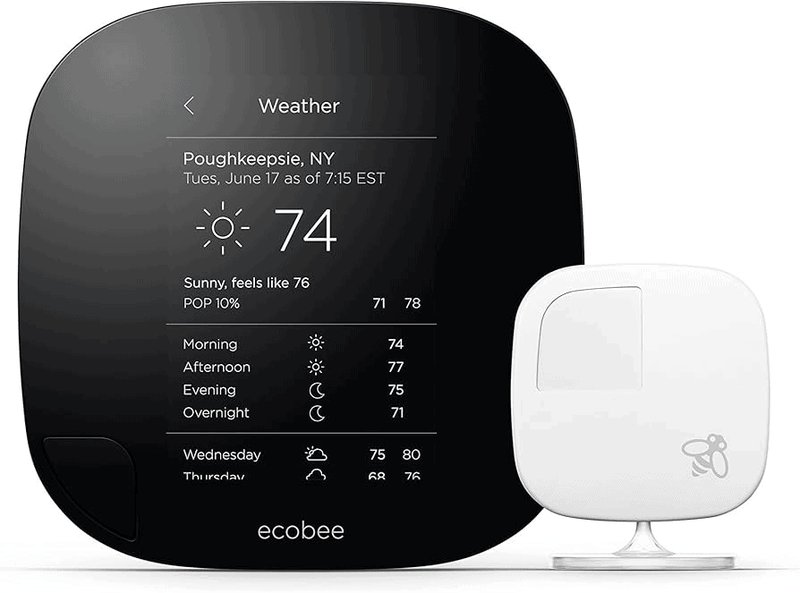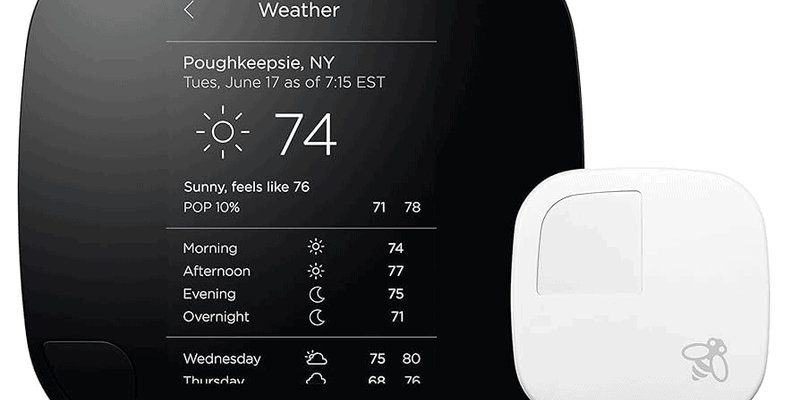
An Ecobee smart remote (sometimes called the “SmartSensor”) is no ordinary remote. It sits in any room, quietly reading the temperature and sensing if anyone’s around. Your thermostat then uses that info to heat or cool the rooms people actually use. On paper, it’s a simple idea. In practice, tech always likes to throw curveballs. So, here’s how to get yours working smoothly again, broken down to basics, like you’re fixing it over coffee with a friend.
Common Problems With Ecobee Smart Remotes
Before diving into solutions, let’s make sense of what usually goes wrong with these sensors. If yours is misbehaving, it’s probably one of three things: it’s lost its connection, it can’t pair with the thermostat, or the battery has given up the ghost.
Honestly, the most common headache is the remote losing sync with the thermostat. You walk into a room, expect comfort, and the system doesn’t respond — it’s like being stood up by your own house. Other times, it’s a pairing issue right out of the box. Maybe you tried setting things up and the thermostat just won’t recognize the sensor. Lastly, the simplest trouble is the battery. If you’ve got a blinking red light (or no light at all), power could be the culprit.
You might be wondering: “Why so many issues for such a small device?” Part of it’s the wireless tech — the sensor talks over radio waves, and your home is full of things that can interfere. Thick walls, Wi-Fi signals, even a microwave on the fritz can throw off its game.
Resetting and Re-Pairing Your Ecobee Smart Remote
Sometimes, the only way to clear a glitch is the classic reset. Think of it like turning your phone off and on when it’s laggy. Ecobee remotes have a simple reset process that often brings them back to life.
To reset and re-pair your sensor:
- Remove the battery by gently popping open the sensor’s back cover.
- Wait 30 seconds. (It’s tempting to rush, but honestly, a short “time out” clears stored code and memory bugs.)
- Snap the battery back in, making sure it’s snug and the contacts are clean.
- On your Ecobee thermostat, go to “Settings” > “Sensors” > “Add Sensor.”
- Hold the sensor close to the thermostat during pairing — less than 2 feet away works best.
If you get a pairing failure, try again with new batteries, and double-check you’re using the right type (usually a CR-2032 coin cell). These steps fix about 80% of connection issues in my experience. If not, keep reading — we’ll get to deeper tricks.
Fixing Connection and Sync Issues
Let’s say your remote pairs just fine, but three days later, it drops offline. That’s like training your cat to come to dinner, then finding it napping in the neighbor’s yard. Here’s the thing: signal interference is a sneaky culprit. If your sensor is on the far side of a thick wall, or sandwiched between big electronics, that weak radio signal might not make it back to your thermostat.
Here’s how to improve the connection:
- Move the remote to a more open spot, away from metal surfaces and appliances.
- Avoid putting the sensor inside cabinets or behind curtains — out of sight means out of range.
- If possible, reduce the distance to the thermostat. Most Ecobee sensors have a range of up to 45 feet, but real life (and drywall) can shrink that quickly.
Still no luck? Try resetting both the thermostat and the sensor. Sometimes, the main unit just needs a fresh handshake. Reboot the thermostat by pulling it off the wall plate for a minute, then reattach. Patience helps — let everything power up before checking if the sensor magically reappears.
Replacing the Ecobee Remote Battery Safely
Batteries are supposed to last over a year, but sometimes they drain faster — especially in cold rooms or if the sensor’s working overtime. If your Ecobee remote shows low battery or stops responding, it’s time for a swap.
Here’s the safest way:
- Gently open the back of the remote using a fingernail or small flat tool.
- Pop out the old CR-2032 battery. Wait a few seconds.
- Slide in a fresh, name-brand battery (cheap knockoffs don’t last as long and sometimes have bad contacts).
- Make sure the positive side (+) faces up, then snap the cover closed.
Let me explain why genuine batteries matter: Ecobee sensors draw low power, but even a tiny voltage dip can make them drop offline or act up. A good battery keeps everything consistent.
After you change it, the sensor should reconnect automatically. If it doesn’t, you might need to re-pair it. That’s normal, especially if the battery was dead for a while. Just follow the steps in the last section.
How to Check Ecobee Sensor Status and Placement
You might be wondering, “How do I know if my sensor is actually doing anything?” It’s not obvious — they don’t have screens or fancy indicators. But your thermostat can show you what’s going on.
Here’s how to check:
- Open the Ecobee app or use the thermostat screen. Go to “Sensors.”
- Make sure your remote sensor shows as “Connected.” If it’s grayed out or says “Offline,” there’s a problem.
- Check the temperature reading and occupancy status. Move in front of the sensor — you should see it mark the room as “Occupied.”
Placement matters more than you think. If you put the sensor in a hallway or next to a vent, you might get wild temperature swings or false “Occupied” readings. Find a room where people spend time (like a family room or bedroom), and place the sensor on a shelf or table about chest height. Avoid direct sunlight and drafty windows — both can mess up readings.
A well-placed sensor is like an honest friend: it gives you a better reading of what’s really happening. Don’t hide it away.
Dealing With Firmware and App Update Glitches
Sometimes, the sensor itself isn’t the problem — your Ecobee thermostat or app might be acting flaky. Software updates are supposed to make things better, but let’s be real: updates can bring their own headaches.
Here’s how to check if software is the issue:
- On your thermostat, check for firmware updates under Settings > About > Version.
- Update the Ecobee app on your phone to the latest version from the app store.
- Restart your phone and thermostat after any updates — this clears out old code that might cause bugs.
If your remote worked fine before an update, and now it won’t sync or keeps disconnecting, there’s a good chance the new version changed something behind the scenes. In most cases, updates stabilize after a day or two. If not, remove and re-pair the sensor. If you’re still stuck, Ecobee support can walk you through deeper resets or send a replacement if there’s a known bug.
Ecobee Smart Remote vs Universal Remotes: Why It Matters
You might be tempted to use a universal remote or sensor from another brand, thinking all temperature sensors are the same. Honestly? They aren’t. Ecobee’s smart remote uses its own code and is built to talk directly to Ecobee thermostats. A universal remote might look similar, but it won’t sync, pair, or report readings back to your Ecobee system.
Here’s what sets the Ecobee remote apart:
- Real-time sync: The sensor instantly reports temps and occupancy back to your thermostat.
- Easy pairing: The set-up process is built into the Ecobee app and interface.
- Security: Communication is encrypted, so random devices can’t spoof a signal.
If you’re using a third-party device, you’ll likely run into problems like failed pairing, weird battery behavior, or the sensor not showing up in the Ecobee app at all. Save yourself the headache and stick with the brand’s own remotes for the best experience.
When To Contact Ecobee Support
Most issues with your smart remote can be fixed at home, but sometimes you hit a wall. If you’ve tried resetting, replacing batteries, moving the sensor, and updating firmware — and it’s still not working — it’s time to phone a friend.
Ecobee’s support team is known for being helpful and pretty quick to respond. Have your thermostat’s serial number, the sensor’s code (found inside the back cover), and a list of what you’ve already tried. Honestly, the more details you give, the faster they’ll help you get back on track.
Don’t feel bad if you can’t solve it yourself. Sometimes devices are just defective out of the box, or a software bug causes havoc. That’s what warranties and support are for.
Wrapping Up: Getting The Most Out Of Your Ecobee Smart Remote
Troubleshooting your Ecobee smart remote is a bit like detective work. Sometimes the solution is as simple as swapping a battery. Other times, you’ll experiment with placement, reset the device, or tinker with the software. The key is to go slow, follow each step, and try not to get too frustrated. These remotes are clever once they’re up and running, and they genuinely make life more comfortable if you set them up right.
If you hit a snag, just remember — most problems have a fix, even if it takes a little patience. With the tips above, your Ecobee system should be humming along, keeping every room in your house just the way you like it. And if all else fails, there’s always support to help you out. Happy troubleshooting!
